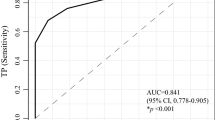Abstract
Previous reports have suggested that laryngopharyngeal reflux (LPR) may cause halitosis. However, it remains unclear if LPR is a risk factor for halitosis. The aim of this study was to investigate if patients diagnosed with LPR have an increased probability of halitosis compared to a normal population. Fifty-eight patients complaining of LPR symptoms and 35 healthy subjects were included in the study. A LPR diagnosis was made using an ambulatory 24-h double pH-probe monitor, which is the gold standard diagnostic tool for LPR. Additionally, halitosis was evaluated by measuring the levels of volatile sulphur compounds using OralChroma™ and an organoleptic test score. The result of the final diagnosis of the 58 patients after the 24 h ambulatory pH monitoring was that 42 patients had LPR. Significant correlations were observed between the organoleptic test score and hydrogen sulfide (H2S) and methyl mercaptan (CH3SH) levels. These were also significantly correlated with LPR. We found a strong positive association between LPR and volatile sulphur compound levels. The H2S and CH3SH levels differed significantly between the LPR and control groups (p < 0.0001 and p < 0.0001, respectively). Halitosis was significantly associated with the occurrence and severity of LPR. The present study provides clear evidence for an association between halitosis and LPR. Halitosis has a high frequency in patients with LPR and reflux characteristics are directly related to their severity and therefore could be considered as a manifestation of LPR.

Similar content being viewed by others
References
Ayazi S, Hagen JS, Zehenter R (2010) Loss of alkalization in proximal esophagus: a new diagnostic paradigm for patients with laryngopharyngeal reflux. J Gastrointest Surg 14:1653–1659
Chorti MS, Prokopakis EP, Lahanas VA (2013) Knowledge of primary care doctors about laryngopharyngeal reflux disease. B ENT 9:53–56
Friedman M, Hamilton C, Samuelson G (2012) The value of routine pH monitoring in the diagnosis and treatment of laryngopharyngeal reflux. Otolaryngol Head Neck Surg 146:952–958
Tangerman A (2002) Halitosis in medicine: a review. Int Dent J 52:201–206
Tonzetich J (1997) Production and origin of oral malodor: a review of mechanisms and methods of analysis. J Periodontol 48:13–20
Tangerman A, Winkel EG (2008) The portable gas chromatograph OralChroma™: a method of choice to detect oral and extra-oral halitosis. J Breath Res. doi:10.1088/1752-7155/2/1/017010
Belafsky PC, Postma GN, Koufman JA (2002) Validity and reliability of the reflux symptom index (RSI). J Voice 16:274–277
Belafsky PC, Postma GN, Koufman JA (2001) The validity and reliability of the reflux finding score (RFS). Laryngoscope 111:1313–1317
Smit CF, Tan J, Devriese PP et al (1998) Ambulatory pH measurements at the upper esophageal sphincter. Laryngoscope 108:299–302
Reichel O, Issing WJ (2008) Impact of different pH thresholds for 24-h dual probe pH monitoring in patients with suspected laryngopharyngeal reflux. J Laryngol Otol 122:485–489
Rosenberg M (1996) Clinical assessment of bad breath: current concepts. J Am Dent Assoc 127:475–482
Delahunty JE, Cherry J (1968) Experimentally produced vocal cord granulomas. Laryngoscope 78:1941–1947
Farrokhi F, Vaezi MF (2007) Laryngeal disorders in patients with gastroesophageal reflux disease. Minerva Gastroenterol Dietol 53:181–187
Koufman JA, Aviv JE, Casiano RR et al (2002) Laryngopharyngeal reflux: position statement of the committee on speech, voice, and swallowing disorders of the American Academy of Otolaryngology-Head and Neck Surgery. Otolaryngol Head Neck Surg 127:32–35
Musser J, Kelchner L, Neils-Strunjas J et al (2011) A comparison of rating scales used in the diagnosis of extraesophageal reflux. J Voice 25:293–300
Merati AL, Lim HJ, Ulualp SO et al (2005) Meta-analysis of upper probe measurements in normal subjects and patients with laryngopharyngeal reflux. Ann Otol Rhinol Laryngol 114:177–182
Fusconi Massimo, De Virgilio Armando, Conte Michela et al (2013) The importance of the number of reflux episodes in the diagnosis of laryngopharyngeal reflux disease. Otolaryngol Head Neck Surg 148:261–266
Struch F, Schwahn C, Wallaschofski H et al (2008) Self-reported halitosis and gastro-esophageal reflux disease in the general population. J Gen Int Med 23:260–266
Yoo SH, Jung HS, Sohn WS et al (2008) Volatile sulfur compounds as a predictor for esophagogastroduodenal mucosal injury. Gut Liver 2:113–118
Kim JG, Kim YJ, Yoo SH et al (2010) Halimeter ppb levels as the predictor of erosive gastroesophageal reflux disease. Gut Liver 4:320–325
Wilder-Smith CH, Wilder-Smith P, Kawakami-Wong H et al (2009) Quantification of dental erosions in patients with GERC using optical coherence tomography before and after double-blind, randomized treatment with esomeprazole or placebo. Am J Gastroenterol 104:2788–2795
Juliane AM, Patrícia G, Rafaela CS et al (2013) Gastroesophageal reflux, dental erosion, and halitosis in epidemiological surveys: a systematic review. Eur J Gastroenterol Hepatol 25:135–141
Author information
Authors and Affiliations
Corresponding author
Ethics declarations
Conflict of interest
The authors declare that they have no conflict of interest.
Financial disclosure
Nothing to declare.
Ethical approval
All procedures performed in studies involving human participants were in accordance with the ethical standards of the institutional and/or national research committee and with the 1964 Helsinki declaration and its later amendments or comparable ethical standards.
Informed consent
Informed consent was obtained from all individual participants included in the study.
Rights and permissions
About this article
Cite this article
Avincsal, M.O., Altundag, A., Ulusoy, S. et al. Halitosis associated volatile sulphur compound levels in patients with laryngopharyngeal reflux. Eur Arch Otorhinolaryngol 273, 1515–1520 (2016). https://doi.org/10.1007/s00405-016-3961-1
Received:
Accepted:
Published:
Issue Date:
DOI: https://doi.org/10.1007/s00405-016-3961-1




